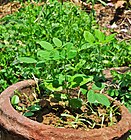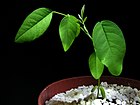Note: This is a project under development. The articles on this wiki are just being initiated and broadly incomplete. You can Help creating new pages.
Difference between revisions of "Clitoria ternatea - Aparajita"
| Line 4: | Line 4: | ||
Clitoria ternatea is commonly known as Asian pigeonwings, bluebellvine, blue pea, butterfly pea, cordofan pea and Darwin pea, is a plant species belonging to the Fabaceae family. The flowers of this vine have the shape of human female genitals, hence the Latin name of the genus "Clitoria", from "clitoris". | Clitoria ternatea is commonly known as Asian pigeonwings, bluebellvine, blue pea, butterfly pea, cordofan pea and Darwin pea, is a plant species belonging to the Fabaceae family. The flowers of this vine have the shape of human female genitals, hence the Latin name of the genus "Clitoria", from "clitoris". | ||
| + | |||
| + | ==Uses== | ||
| + | |||
| + | {{Uses|Blisters in mouths}}, {{Uses|mouth sores}}, {{Uses|bleeding piles}}, {{Uses|leucorrhoea}}, {{Uses|Mild diabetes}}, {{Uses|Cough}}, {{Uses|physical weakness}}, {{Uses|ulcer}}, {{Uses|Urinary trouble}}, {{Uses|snakebite}}, {{Uses|infection in intestine}}. | ||
| + | |||
| + | ==Parts Used== | ||
| + | {{Parts Used|mature seeds}}, {{Parts Used|stem}}, {{Parts Used|leaves}}, {{Parts Used|Root}}. | ||
| + | |||
| + | ==Chemical Composition== | ||
| + | Mature seeds contain alkali like abrine, precatorine, etc., abraline; toxalbumin like abrin I, II, III, etc., abrus agglutinin I, II (A. P. A Ⅰ, Ⅱ), sterols like abricin, squnalene, alcohol likeβ-amyrin, cycloartenol, 5β-cholanic acid, abrussic acid, sophoradiol, trimethyltryptophan abrusin galactose, arabinose, xylose, polysaccharide and flavonoids compounds, Seed covers contain gallic acid, abranin), delphinidin.<ref name="chemical composition"/> | ||
| + | |||
| + | ==Common names== | ||
| + | {{Common names|kn=Gulaganji|ml=Kunni, Kunnikkuru|sa=Gunja|ta=Gundumani, Kundumani|te=Gurivinda or Guriginja|hi=Gaungchi, Gunchi|en=equirity}} | ||
| + | |||
| + | ==Habit== | ||
| + | {{Habit| A small wiry straggler(5m)}} | ||
| + | |||
| + | ==Identification== | ||
| + | ===Leaf=== | ||
| + | {{Leaf|Paripinnate|Oblong|Leaf Arrangementis Alternate-spiral}}.<ref name="Leaf"/> | ||
| + | |||
| + | ===Flower=== | ||
| + | {{Flower|Unisexual|2-4cm long|pink||Flowering throughout the year and In terminal and/or axillary pseudoracemes}} | ||
| + | |||
| + | ===Fruit=== | ||
| + | {{Fruit|oblong pod|Thinly septate, pilose, wrinkled||seeds upto 5|Fruiting throughout the year}} | ||
| + | |||
| + | ===Other features=== | ||
| + | |||
| + | ==List of Ayurvedic medicine in which the herb is used== | ||
| + | * [[Vishatinduka Taila]] as ''root juice extract'' | ||
| + | |||
| + | ==Where to get the saplings== | ||
| + | ==Mode of Propagation== | ||
| + | {{Propagation|Seeds}}. | ||
| + | |||
| + | ==How to plant/cultivate== | ||
| + | The more common species of Aconitum are generally those cultivated in gardens, especially hybrids. They typically thrive in well-drained evenly moist garden soils like the related hellebores and delphiniums, and can grow in the shade of trees. | ||
| + | |||
| + | ==Commonly seen growing in areas== | ||
| + | {{Commonly seen|tropical}}, {{Commonly seen|Caribbean Islands}}, {{Commonly seen|subtropical}}, {{Commonly seen|pinelands}}, {{Commonly seen|hammocks}}. | ||
| + | |||
| + | ==Photo Gallery== | ||
| + | <gallery class="left" caption="" widths="140px" heights="140px"> | ||
| + | File:Clitoria ternatea in jaffna.JPG|{{Is QI}} | ||
| + | File:Clitoria ternatea 17 07 2013.jpg|{{Is QI}} | ||
| + | File:Clitoria ternatea plants 15042014.jpg|{{Is QI}} | ||
| + | File:Clitoria ternatea20130613 03.jpg|{{Is QI}} | ||
| + | File:Clitoria ternatea20130624 07.jpg|{{Is QI}} | ||
| + | File:Clitoria ternatea20130714 29.jpg|{{Is QI}} | ||
| + | Clitoria ternatea20130716 07.jpg|{{Is QI}} | ||
| + | Clitoria ternatea20130716 17.jpg|{{Is QI}} | ||
| + | File:Starr_980529-1406_Clitoria_ternatea.jpg | ||
| + | </gallery> | ||
| + | |||
| + | ==References== | ||
| + | |||
| + | <references> | ||
| + | <ref name="chemical composition">[https://web.archive.org/web/20130728111350/http://libproject.hkbu.edu.hk/was40/detail?lang=en&channelid=1288&searchword=herb_id%3DD01344 "medicinal plant database"]</ref> | ||
| + | <ref name="Leaf">[https://indiabiodiversity.org/species/show/32002 "boidiversity india"]</ref> | ||
| + | </references> | ||
| + | |||
| + | ==External Links== | ||
| + | * | ||
| + | |||
| + | |||
| + | [[Category:Herbs]] | ||
Revision as of 17:05, 6 April 2018
Clitoria ternatea is commonly known as Asian pigeonwings, bluebellvine, blue pea, butterfly pea, cordofan pea and Darwin pea, is a plant species belonging to the Fabaceae family. The flowers of this vine have the shape of human female genitals, hence the Latin name of the genus "Clitoria", from "clitoris".
Contents
Uses
Blisters in mouths, mouth sores, bleeding piles, leucorrhoea, Mild diabetes, Cough, physical weakness, ulcer, Urinary trouble, snakebite, infection in intestine.
Parts Used
mature seeds, stem, leaves, Root.
Chemical Composition
Mature seeds contain alkali like abrine, precatorine, etc., abraline; toxalbumin like abrin I, II, III, etc., abrus agglutinin I, II (A. P. A Ⅰ, Ⅱ), sterols like abricin, squnalene, alcohol likeβ-amyrin, cycloartenol, 5β-cholanic acid, abrussic acid, sophoradiol, trimethyltryptophan abrusin galactose, arabinose, xylose, polysaccharide and flavonoids compounds, Seed covers contain gallic acid, abranin), delphinidin.[1]
Common names
| Language | Common name |
|---|---|
| Kannada | Gulaganji |
| Hindi | Gaungchi, Gunchi |
| Malayalam | Kunni, Kunnikkuru |
| Tamil | Gundumani, Kundumani |
| Telugu | Gurivinda or Guriginja |
| Marathi | NA |
| Gujarathi | NA |
| Punjabi | NA |
| Kashmiri | NA |
| Sanskrit | Gunja |
| English | equirity |
Habit
Identification
Leaf
| Kind | Shape | Feature |
|---|---|---|
| Paripinnate | Oblong | Leaf Arrangementis Alternate-spiral |
.[2]
Flower
| Type | Size | Color and composition | Stamen | More information |
|---|---|---|---|---|
| Unisexual | 2-4cm long | pink | Flowering throughout the year and In terminal and/or axillary pseudoracemes |
Fruit
| Type | Size | Mass | Appearance | Seeds | More information |
|---|---|---|---|---|---|
| oblong pod | Thinly septate, pilose, wrinkled | seeds upto 5 | Fruiting throughout the year | {{{6}}} |
Other features
List of Ayurvedic medicine in which the herb is used
- Vishatinduka Taila as root juice extract
Where to get the saplings
Mode of Propagation
How to plant/cultivate
The more common species of Aconitum are generally those cultivated in gardens, especially hybrids. They typically thrive in well-drained evenly moist garden soils like the related hellebores and delphiniums, and can grow in the shade of trees.
Commonly seen growing in areas
tropical, Caribbean Islands, subtropical, pinelands, hammocks.
Photo Gallery
References
External Links
- Pages that are stubs
- Ayurvedic Herbs known to be helpful to treat Blisters in mouths
- Ayurvedic Herbs known to be helpful to treat mouth sores
- Ayurvedic Herbs known to be helpful to treat bleeding piles
- Ayurvedic Herbs known to be helpful to treat leucorrhoea
- Ayurvedic Herbs known to be helpful to treat Mild diabetes
- Ayurvedic Herbs known to be helpful to treat Cough
- Ayurvedic Herbs known to be helpful to treat physical weakness
- Ayurvedic Herbs known to be helpful to treat ulcer
- Ayurvedic Herbs known to be helpful to treat Urinary trouble
- Ayurvedic Herbs known to be helpful to treat snakebite
- Ayurvedic Herbs known to be helpful to treat infection in intestine
- Herbs with mature seeds used in medicine
- Herbs with stem used in medicine
- Herbs with leaves used in medicine
- Herbs with Root used in medicine
- Herbs with common name in Kannada
- Herbs with common name in Hindi
- Herbs with common name in Malayalam
- Herbs with common name in Tamil
- Herbs with common name in Telugu
- Herbs with common name in Sanskrit
- Herbs with common name in English
- Habit - A small wiry straggler(5m)
- Index of Plants which can be propagated by Seeds
- Herbs that are commonly seen in the region of tropical
- Herbs that are commonly seen in the region of Caribbean Islands
- Herbs that are commonly seen in the region of subtropical
- Herbs that are commonly seen in the region of pinelands
- Herbs that are commonly seen in the region of hammocks
- Herbs









